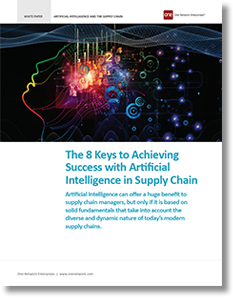8 Signs Your Business-2-Business Cloud Network is Broken

If you are looking at end-to-end automation supply chain solutions for optimizing your enterprise and business network, consideration of these 8 key multi-enterprise network factors will be critical for your success.
Why Your “Network” is Not Delivering the Results You Expect
The confusion in the market about the difference between multi-enterprise (or multi-party) networks and other options, such as Planning and B2B Networks, is rampant.
Yet the differences in performance, maintenance, and implementation are huge.
I looked at some of these differences in my post-Multi-Enterprise Networks versus Pseudo Networks.
Read the Article: Key Differences Concerning Supply Chain Multi-Enterprise Network Platforms & Pseudo Networks
Now I want to give some telltale signs that indicate a so-called network is not what it seems.
1. The proliferation of IT Connections
Beware of old school point to point B2B vendors claiming they have a Multi-Enterprise Network but really require new IT connections between each enterprise pair; and worse, new IT connections between functions across enterprise pairs (demand, inventory, transportation, etc.).
Ask them if they can bring more than two parties onto the same workflow or make instant connections to another company that joined the network previously.
2. A conglomeration of Enterprise Applications
Beware of vendors that have purchased “Single Enterprise Focused” applications designed for use by one company but claim they are now magically “Multi-Enterprise Apps” because the acquiring company has a B2B platform.
These single enterprise applications connected to a legacy B2B cloud platform still function as silo applications with complex (hidden) behind the scenes app-to-app integrations, messy error-prone and often slow data translations between applications, master data management (MDM) cross-referencing, even separate databases.
It doesn’t matter if they use the same RDBMS the application data models are rarely ported to a common data model because it requires expensive rewriting of algorithms and database access code.
These applications connected to legacy cloud platforms also replicate important objects such as orders and planned events. All this causes synchronization, trust and timing issues.
3. Siloed Master Data Models
Beware of B2B vendors who have purchased or have legacy point solutions that run on siloed master data models that they claim work “seamlessly together” but in reality require on project master data mapping and duplicate transactions across their own application persistent stores (no true single version of truth across all parties and business functions on the network).
This creates elongated and overly complicated deployment projects which drive up technical debt and costly maintenance which inhibits future business agility and automation.
4. Separate Planning and Execution Systems
Beware of the high labor costs associated with operating and maintaining supply chain solutions designed around planning that rely on “other systems” for execution and one-off data aggregation projects for visibility.
In order to really automate your end to end network planning must be designed to understand, modify and create real-time transactions (orders, events, instructions) as well as workflows and processes that traverse multiple companies in your network.
Trying to bridge your planning system to your internal execution systems (often Enterprise Resource Planning systems), is expensive and results in clunky and costly integrations, but more importantly, the planning and execution with your partners are left to pinhole B2B data transfers that undermine your ability to optimize and automated the entire end-to-end network.
If you find that your data planning data models and policies diverge from reality, or you have to spin up special projects to feed your planning data models with accurate data such as real-time asset locations, inventory status, real transportation lead times, capacities, etc., you are suffering the symptoms of the divide between planning and execution which will inhibit your ability to automate and optimize your network.
5. Automation Without Multi-Enterprise Coordination
Beware of solutions that claim they provide end-to-end visibility and automation when they are lacking multi-party workflows with shared applications on a shared real-time single version of the truth (SVOT).
Many companies have invested heavily in B2B platforms and best of breed planning systems so why can’t they realize end-to-end automation and optimize their networks?
To automate your end-to-end network you must have a platform and applications that are designed from the ground up for multi-enterprise shared processes and algorithms: sense, learn, predict, plan, execute, measure). This requires multi-party permissions infused in all dimensions of the platform, not just user roles and screen views.
One clear red flag that you don’t have a multi-enterprise platform is characterized by processes you have to spend manual time and effort on trying to model the external world in your internal application models such as external sites, lanes, lead times, capacities, inventory locations, etc. for entities that you don’t own.
A multi-enterprise platform will have a multi-enterprise MDM system that allows each party to maintain the part of the network they own which keeps the network model in synch with reality which in turn enables feasible automated decisions to be made and drives the accuracy and trust required to transition to an end-to-end automated state.
6. Scalable Without Self-Tuning and Learning
Beware of solutions that claim scalability and massive parallel planning capabilities but are not self-tuning, lack focused learning and require “planners” to continually update policies, data models and rely on static data model parameters.
Ask your planners why they are still using Excel, email and phone calls to partners to “fill in the gaps” in their planning and execution processes.
Often, we find that “one company at a time” planning applications (with point to point B2B connections) and different planning and execution cadences between companies results in mismatches between plans, data models, time delays, visibility latency, gaming between parties which inhibits automation and results in extra manual effort and an inability to respond intelligently to fast-changing supply and demand scenarios.
7. Deep Neural Networks are Only Part of the Solution
Beware of Artifical Intelligence (AI) solution vendors that claim one massive Deep Neural Network (DNN) will solve all their supply chain problems.
In reality, many types of algorithms working together provide a much more effective and pragmatic approach to solving the vast array of network problems companies and networks encounter.
Download the White Paper: 8 Keys to Achieving Success with Artificial Intelligence in Supply Chain
When you can get the right answer with a heuristic or other type of manually crafted algorithm there is no need to waste time and increase complexity by training a DNN for that task.
Using DNNs in the right area with the ability for DNN digital agents to work with other types of digital agent algorithms enables a pragmatic, controllable and superior approach to optimizing the entire end-to-end network.
8. Lack of Digital Agents and a Digital Agent Fabric
Recognizing patterns with DNNs and Analytics is only part of the equation to enabling end-to-end network automation and optimization.
Decisions need to be executed automatically to take advantage of fast moving and short time frame issues.
Without digital agents that can predict issues, issue impact and act on mitigation options to solve the problems automatically much of the value of DNNs and Analytics is lost.
Also, networks can be enormous which requires a scalable design. Our [One Network] approach to scalability revolves around dynamically breaking networks up into subnets and attaching an array of digital agents to each subnet to realize near real-time decision making and automation across global networks.
When a problem cannot be solved on a local subnet the system enables cross subnet decision making enabling a horizontally scalable platform that adjusts to both small and massive business networks.
This design allows the system to adopt policies (forecasting, inventory, transportation, procurement, replenishment, etc.) and decisions for each subnet to accommodate local behaviors of your network actors: customers, suppliers, carriers, channels, factories, etc.
The Right Questions Can Save You from a Costly Mistake
If you are looking for end-to-end and automation solutions for optimizing your enterprise and your business network, consideration of these key factors will be critical for success.
Betting on a cobbled together best of breed “one enterprise design applications” application strategy (combined with a hub and spoke B2B platform) is high risk and high-cost strategy that is sure to disappoint.
About the Author
Geoff Annesley is a member of One Network’s Executive Staff and is responsible for sales and product strategy for One Network's High Tech and CPG verticals. He has a proven track record in growing internet SaaS startups, introducing new technology to markets, and successfully defining and executing go to market strategies for new services and technology, including Multi-Party Enterprise Solutions, IoT, PaaS, SaaS, Performance Services, Application and Platform Services for Enabling the New Circular Economy.
Related Article: How to Choose & Derive Optimal Value from a Control Tower
Related White Papers
One Network: IDC MarketScape Multi-Enterprise Supply Chain Commerce Network Assessment New!
In this research paper, “IDC MarketScape: how Multi-Enterprise Supply Chain Commerce Network 2018 Vendor Assessment,” describes the companies that will be “driving productivity gains of 2 Percent” and how the supply chain technology landscape is rapidly changing. Download Now!
8 Keys to Achieving Success with Artificial Intelligence in Supply Chain
This white paper looks at the fundamentals that supply chains need in place in order to achieve real results from Artificial Intelligence implementations. Download Now!
Control Tower Technology Value Matrix 2018
In this Value Matrix report, Nucleus evaluated the control market vendors based on their product usability and functionality and the value that customers realize from the capabilities of the product. Download Now!
Article Topics
One Network Enterprises News & Resources
Blue Yonder announces an agreement to acquire One Network Enterprises for $839 million Blue Yonder Acquires One Network Enterprises for $839M Companies Need to Develop New Innovative Approaches to Supply Chain Design How to Improve Cost of Goods Sold Horizontally Across the Supply Chain How the Global Pandemic Accelerated Supply Chain Visibility, Digitalization, and Automation AI and Data, the Future of Supply Chain Management AI and Supply Chain Problem Solving More One Network EnterprisesLatest in Supply Chain
Microsoft Unveils New AI Innovations For Warehouses Let’s Spend Five Minutes Talking About ... Malaysia Baltimore Bridge Collapse: Impact on Freight Navigating TIm Cook Says Apple Plans to Increase Investments in Vietnam Amazon Logistics’ Growth Shakes Up Shipping Industry in 2023 Spotlight Startup: Cart.com is Reimagining Logistics Walmart and Swisslog Expand Partnership with New Texas Facility More Supply Chain














